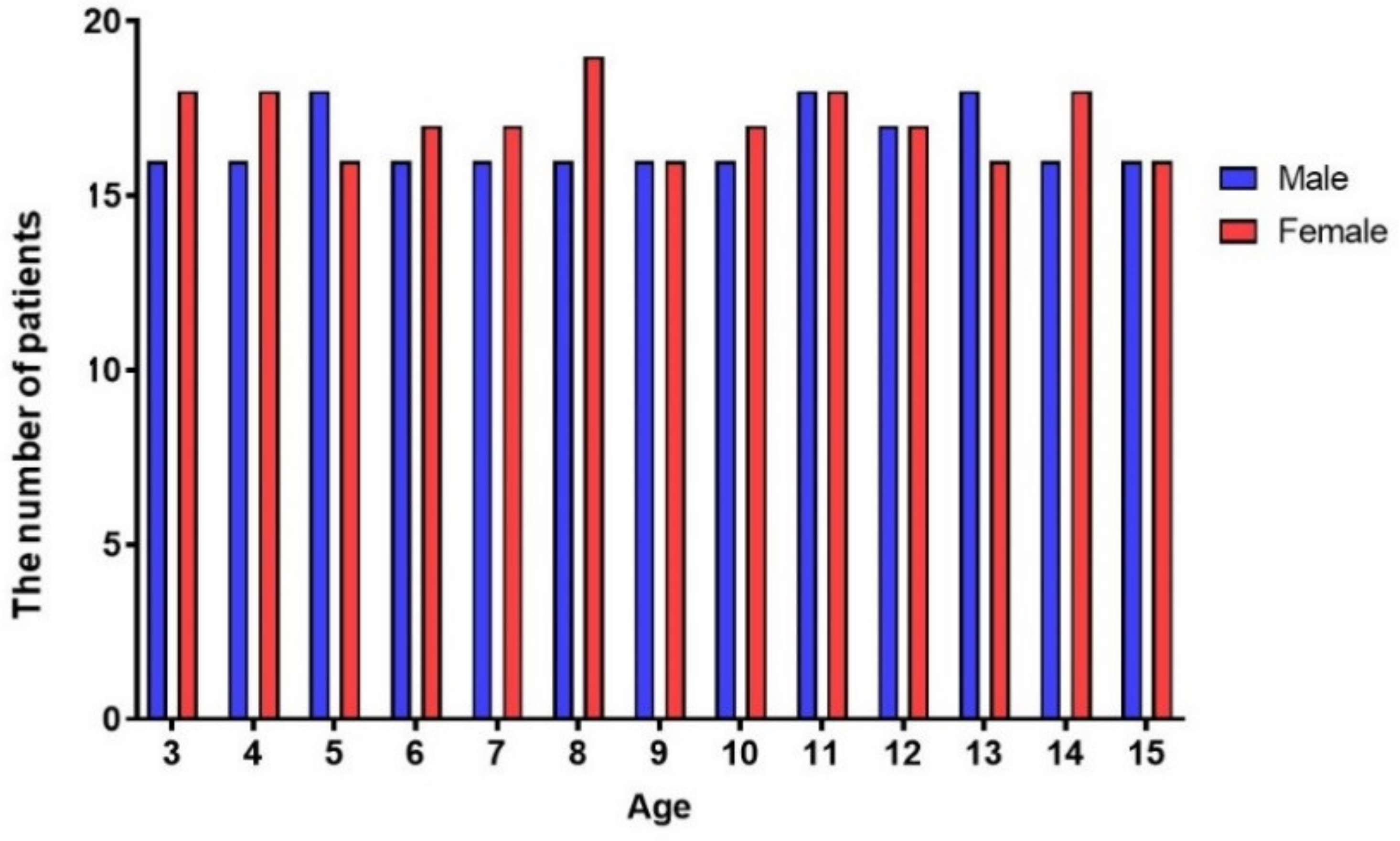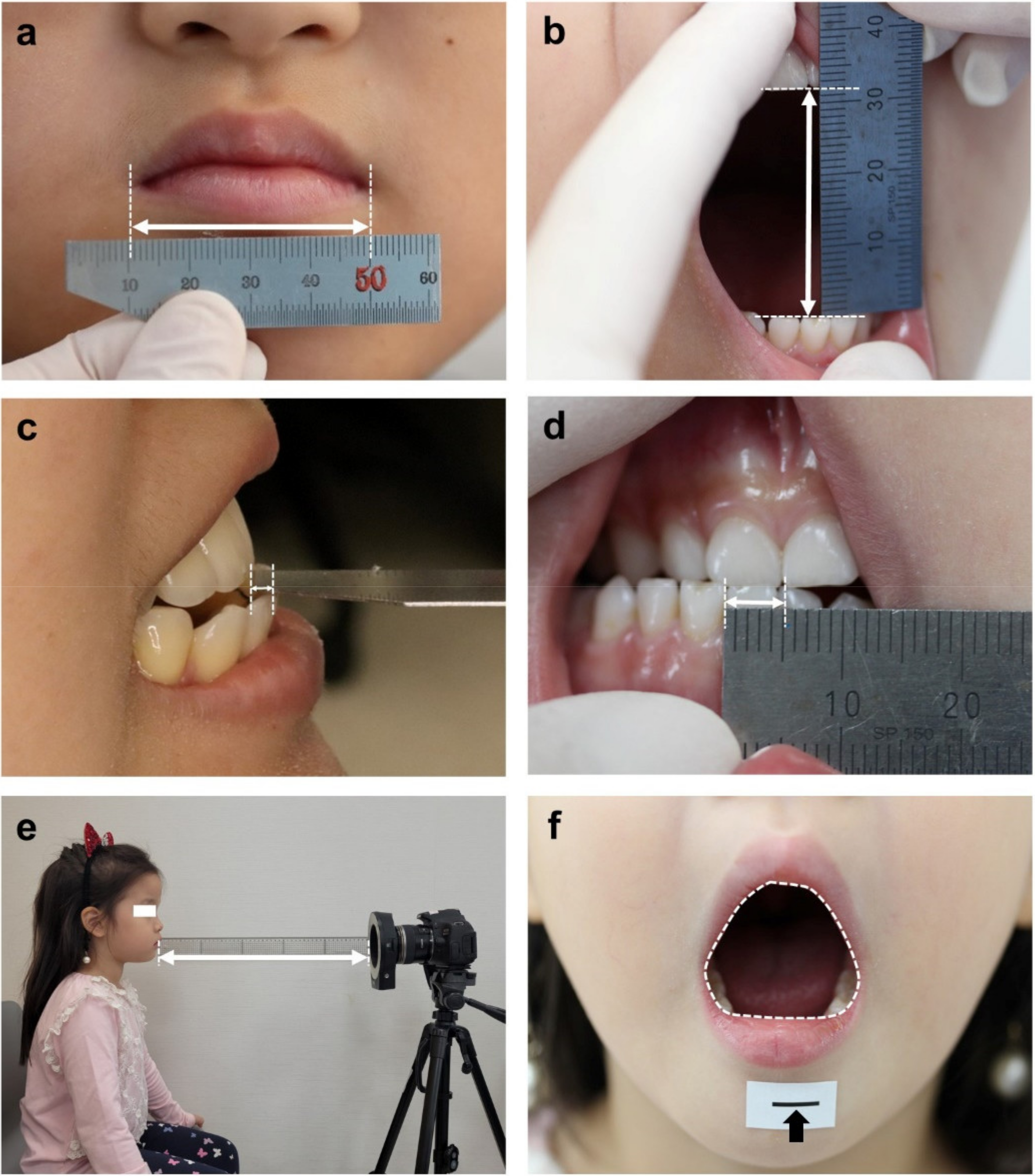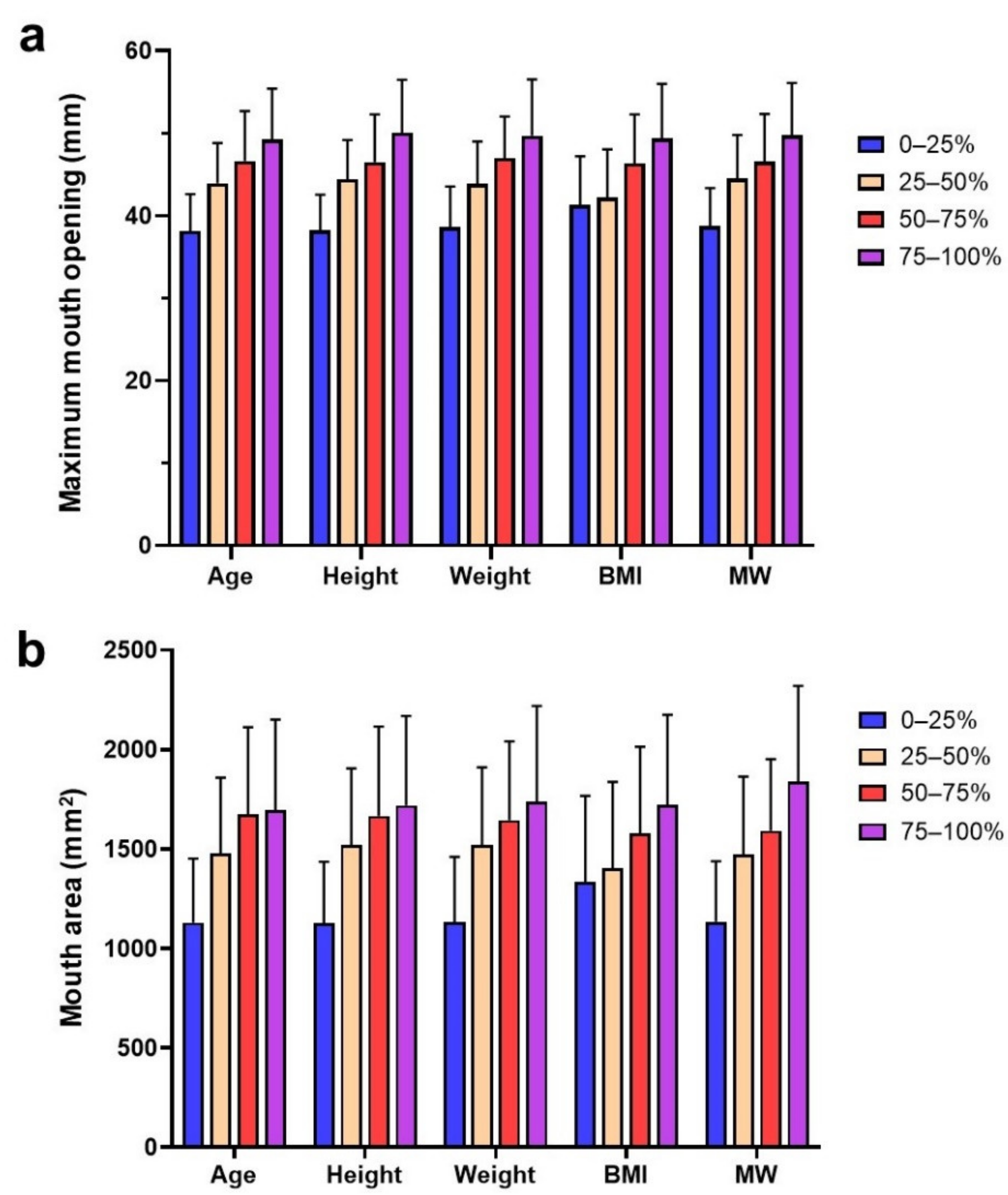An Analysis of the Temporomandibular Joint Range of Motion and Related Factors in Children and Adolescents
Abstract
1. Introduction
2. Materials and Methods
2.1. Participants
2.2. Measurement: Height, Weights and BMI
2.3. Measurement: MW
2.4. Measurement: TMJROM
2.5. Measurement: MA
2.6. Statistical Analyses
3. Results
3.1. Internal Consistency
3.2. MMO and MA According to Sex, Age, Height, Weight, BMI, and MW
3.3. Protrusion and Laterotrusion According to Sex, Age, Height, Weight, BMI, and MW
3.4. Correlation Analysis
3.5. Multiple Linear Regression Analysis
4. Discussion
5. Conclusions
Author Contributions
Funding
Institutional Review Board Statement
Informed Consent Statement
Data Availability Statement
Acknowledgments
Conflicts of Interest
Appendix A
| Valid n | Missing n | % | Cronbach α | |
|---|---|---|---|---|
| Mouth width | 433 | 5 | 98.9 | 0.974 |
| Maximum mouth opening | 437 | 1 | 99.8 | 0.975 |
| Protrusion | 344 | 94 | 78.5 | 0.955 |
| Right lateral laterotrusion | 330 | 108 | 75.3 | 0.921 |
| Left lateral laterotrusion | 333 | 105 | 76.0 | 0.940 |
| Mouth area | 417 | 21 | 95.2 | 0.999 |
| Related Factors | Entire Group | Quartile Group | p | |||
|---|---|---|---|---|---|---|
| N | ||||||
| (mm) | 0–25% | 25–50% | 50–75% | 75–100% | ||
| Age (years) | 3–6 | 6–9 | 9–12 | 12–15 | ||
| MMO | 438 | 102 | 101 | 101 | 134 | <0.001 * |
| 44.8 ± 6.9 | 38.2 ± 4.5 | 44.0 ± 4.9 | 46.6 ± 6.1 | 49.3 ± 6.2 | ||
| P | 345 | 50 | 81 | 86 | 128 | 0.026 * |
| 7.1 ± 2.1 | 6.3 ± 2.1 | 6.9 ± 2.0 | 7.3 ± 2.0 | 7.3 ± 2.3 | ||
| RL | 332 | 38 | 77 | 89 | 128 | 0.697 |
| 7.6 ± 2.1 | 7.3 ±2.2 | 7.4 ± 2.0 | 7.5 ± 2.2 | 7.7 ± 2.0 | ||
| LL | 337 | 38 | 80 | 90 | 129 | 0.162 |
| 7.5 ± 2.3 | 7.2 ± 1.7 | 7.5 ± 2.0 | 7.9 ± 2.5 | 7.3 ± 2.4 | ||
| MA | 417 | 94 | 97 | 95 | 131 | <0.001 * |
| 1511.6 ± 463.2 | 1130.1 ± 321.4 | 1477.5 ± 380.1 | 1672.8 ± 439.3 | 1693.6 ± 456.2 | ||
| Height (cm) | 95.0–118.2 | 118.2–135.4 | 135.4–156.6 | 156.6–185.0 | ||
| MMO | 437 | 109 | 108 | 110 | 110 | <0.001 * |
| 44.8 ± 6.9 | 38.2 ± 4.4 | 44.4 ± 4.8 | 46.5 ± 5.8 | 50.1 ± 6.4 | ||
| P | 344 | 54 | 89 | 95 | 106 | 0.003 * |
| 7.1 ± 2.1 | 6.1 ± 2.1 | 7.2 ± 1.9 | 7.3 ± 2.0 | 7.2 ± 2.3 | ||
| RL | 331 | 43 | 84 | 100 | 104 | 0.335 |
| 7.5 ± 2.1 | 7.3 ± 1.8 | 7.6 ± 2.1 | 7.3 ± 2.3 | 7.8 ± 2.0 | ||
| LL | 336 | 43 | 86 | 101 | 106 | 0.776 |
| 7.5 ± 2.2 | 7.2 ± 1.7 | 7.6 ± 2.0 | 7.6 ± 2.6 | 7.4 ±2.3 | ||
| MA | 416 | 102 | 103 | 103 | 108 | <0.001 * |
| 1511.2 ± 463.7 | 1126.1 ± 310.1 | 1520.2 ± 384.6 | 1665.4 ± 450.0 | 1719.2 ± 448.6 | ||
| Weight (kg) | 13.6–21.1 | 21.1–33.9 | 33.9–49.2 | 49.2–110.0 | ||
| MMO | 437 | 109 | 109 | 108 | 111 | <0.001 * |
| 44.8 ± 6.9 | 38.6 ± 4.9 | 43.9 ± 5.1 | 47.0 ± 5.0 | 49.7 ± 6.8 | ||
| P | 344 | 55 | 86 | 97 | 106 | 0.004 * |
| 7.1 ± 2.1 | 6.2 ± 2.0 | 6.9 ± 2.0 | 7.4 ± 2.2 | 7.3 ± 2.2 | ||
| RL | 331 | 43 | 81 | 102 | 105 | 0.198 |
| 7.5 ± 2.1 | 7.4 ± 2.1 | 7.2 ± 2.0 | 7.6 ±2.3 | 7.8 ± 2.0 | ||
| LL | 336 | 43 | 85 | 101 | 107 | 0.904 |
| 7.5 ± 2.2 | 7.3 ± 1.9 | 7.5 ± 2.4 | 7.5 ± 2.3 | 7.6 ± 2.2 | ||
| MA | 416 | 102 | 103 | 105 | 106 | <0.001 * |
| 1511.2 ± 463.7 | 1131.1 ± 330.0 | 1519.4 ± 390.2 | 1644.1 ± 397.0 | 1737.3 ± 481.8 | ||
| BMI (kg/m2) | 10.2–15.8 | 15.8–17.5 | 17.5–20.7 | 20.7–34.2 | ||
| MMO | 437 | 106 | 111 | 110 | 110 | <0.001 * |
| 44.8 ± 6.9 | 41.3 ± 5.9 | 42.2 ± 5.9 | 46.3 ± 5.9 | 49.4 ± 6.6 | ||
| P | 344 | 73 | 76 | 96 | 99 | 0.024 * |
| 7.1 ± 2.1 | 6.7 ± 1.9 | 6.6 ± 2.0 | 7.3 ± 2.3 | 7.4 ± 2.1 | ||
| RL | 331 | 59 | 74 | 98 | 100 | 0.105 |
| 7.5 ± 2.1 | 7.6 ± 2.3 | 7.1 ± 2.0 | 7.5 ± 2.1 | 7.9 ± 2.0 | ||
| LL | 336 | 61 | 75 | 100 | 100 | 0.548 |
| 7.5 ± 2.2 | 7.4 ± 2.5 | 7.3 ± 2.4 | 7.4 ± 2.1 | 7.7 ± 2.1 | ||
| MA | 416 | 101 | 103 | 106 | 106 | <0.001 * |
| 1511.2 ± 463.7 | 1333.0 ± 433.8 | 1402.2 ± 434.3 | 1576.7 ± 436.7 | 1721.3 ± 453.5 | ||
| MW (mm) | 31.0–39.1 | 39.1–43.0 | 43.0–46.7 | 46.7–63.7 | ||
| MMO | 435 | 109 | 103 | 115 | 108 | <0.001 * |
| 44.9 ± 6.8 | 38.7 ± 4.6 | 44.6 ± 5.3 | 46.6 ± 5.8 | 49.7 ± 6.4 | ||
| P | 345 | 62 | 82 | 103 | 98 | 0.004 * |
| 7.1 ± 2.1 | 6.2 ± 2.0 | 7.1 ± 2.0 | 7.3 ± 2.1 | 7.4 ± 2.2 | ||
| RL | 332 | 49 | 82 | 103 | 98 | 0.010 * |
| 7.6 ± 2.1 | 7.0 ± 2.1 | 7.5 ± 2.2 | 7.3 ± 2.1 | 8.1 ± 1.8 | ||
| LL | 337 | 51 | 83 | 105 | 98 | 0.340 |
| 7.5 ± 2.3 | 7.2 ± 1.7 | 7.2 ± 2.1 | 7.5 ± 2.6 | 7.8 ± 2.2 | ||
| MA | 414 | 101 | 97 | 111 | 105 | <0.001 * |
| 1514.4 ± 463.6 | 1133.7 ± 304.0 | 1472.5 ± 391.3 | 1591.8 ± 359.1 | 1837.3 ± 482.7 | ||
| Unstandardized Coefficients | Std. Coefficients | Collinearity Statistics | |||||
|---|---|---|---|---|---|---|---|
| β | Std. Error | β | T | p | Tolerance | VIF | |
| (Constant) | 18.109 | 4.251 | 4.260 | <0.001 * | |||
| Sex | −0.744 | 0.523 | −0.055 | −1.423 | 0.155 | 0.880 | 1.136 |
| Age | −0.049 | 0.232 | −0.027 | −0.213 | 0.831 | 0.081 | 12.363 |
| Height | 0.060 | 0.044 | 0.203 | 1.362 | 0.174 | 0.058 | 17.257 |
| Weight | 0.091 | 0.033 | 0.244 | 2.792 | 0.005 * | 0.169 | 5.923 |
| Mouth width | 0.372 | 0.073 | 0.293 | 5.065 | <0.001 * | 0.386 | 2.592 |
References
- Westling, L.; Helkimo, E. Maximum jaw opening capacity in adolescents in relation to general joint mobility. J. Oral Rehabil. 1992, 19, 485–494. [Google Scholar] [CrossRef]
- Ito, H.; Kawaai, H.; Yamazaki, S.; Suzuki, Y. Maximum opening of the mouth by mouth prop during dental procedures increases the risk of upper airway constriction. Ther. Clin. Risk Manag. 2010, 6, 239–248. [Google Scholar] [PubMed]
- Chen, H.S.; Yang, P.L.; Lee, C.Y.; Chen, K.K.; Lee, K.T. Analysis of maximum mouth opening and its related factors in 3- to 5-year-old taiwanese children. Odontology 2015, 103, 84–88. [Google Scholar] [CrossRef] [PubMed]
- Muller, L.; van Waes, H.; Langerweger, C.; Molinari, L.; Saurenmann, R.K. Maximal mouth opening capacity: Percentiles for healthy children 4–17 years of age. Pediatr. Rheumatol. Online J. 2013, 11, 17. [Google Scholar] [CrossRef] [PubMed]
- Hirsch, C.; John, M.T.; Lautenschlager, C.; List, T. Mandibular jaw movement capacity in 10-17-yr-old children and adolescents: Normative values and the influence of gender, age, and temporomandibular disorders. Eur. J. Oral Sci. 2006, 114, 465–470. [Google Scholar] [CrossRef] [PubMed]
- Sousa, L.M.; Nagamine, H.M.; Chaves, T.C.; Grossi, D.B.; Regalo, S.C.; Oliveira, A.S. Evaluation of mandibular range of motion in brazilian children and its correlation to age, height, weight, and gender. Braz. Oral Res. 2008, 22, 61–66. [Google Scholar] [CrossRef] [PubMed]
- Schiffman, E.; Ohrbach, R.; Truelove, E.; Look, J.; Anderson, G.; Goulet, J.P.; List, T.; Svensson, P.; Gonzalez, Y.; Lobbezoo, F.; et al. Diagnostic criteria for temporomandibular disorders (dc/tmd) for clinical and research applications: Recommendations of the international rdc/tmd consortium network and orofacial pain special interest groupdagger. J. Oral Facial Pain Headache 2014, 28, 6–27. [Google Scholar] [CrossRef] [PubMed]
- Tavakol, M.; Dennick, R. Making sense of cronbach’s alpha. Int. J. Med. Educ. 2011, 2, 53–55. [Google Scholar] [CrossRef] [PubMed]
- Hinkle, D.E.; Wiersma, W.; Jurs, S.G. Applied Statistics for the Behavioral Sciences, 5th ed.; Houghton Mifflin: Boston, MA, USA, 2003; p. 756. [Google Scholar]
- Miller, V.J.; Bookhan, V.; Brummer, D.; Singh, J.C. A mouth opening index for patients with temporomandibular disorders. J. Oral Rehabil. 1999, 26, 534–537. [Google Scholar] [CrossRef] [PubMed]
- Larheim, T.A.; Hoyeraal, H.M.; Stabrun, A.E.; Haanaes, H.R. The temporomandibular joint in juvenile rheumatoid arthritis. Radiographic changes related to clinical and laboratory parameters in 100 children. Scand. J. Rheumatol. 1982, 11, 5–12. [Google Scholar] [CrossRef] [PubMed]
- Muller, L.; Kellenberger, C.J.; Cannizzaro, E.; Ettlin, D.; Schraner, T.; Bolt, I.B.; Peltomaki, T.; Saurenmann, R.K. Early diagnosis of temporomandibular joint involvement in juvenile idiopathic arthritis: A pilot study comparing clinical examination and ultrasound to magnetic resonance imaging. Rheumatology 2009, 48, 680–685. [Google Scholar] [CrossRef] [PubMed]
- Ayuse, T.; Inazawa, T.; Kurata, S.; Okayasu, I.; Sakamoto, E.; Oi, K.; Schneider, H.; Schwartz, A.R. Mouth-opening increases upper-airway collapsibility without changing resistance during midazolam sedation. J. Dent. Res. 2004, 83, 718–722. [Google Scholar] [CrossRef] [PubMed]
- Dickison, A.E. The normal and abnormal pediatric upper airway. Recognition and management of obstruction. Clin. Chest Med. 1987, 8, 583–596. [Google Scholar] [CrossRef]
- Tecco, S.; Nota, A.; Caruso, S.; Primozic, J.; Marzo, G.; Baldini, A.; Gherlone, E.F. Temporomandibular clinical exploration in italian adolescents. Cranio 2019, 37, 77–84. [Google Scholar] [CrossRef] [PubMed]
- Magnusson, T.; Egermark, I.; Carlsson, G.E. A longitudinal epidemiologic study of signs and symptoms of temporomandibular disorders from 15 to 35 years of age. J. Orofac. Pain 2000, 14, 310–319. [Google Scholar] [PubMed]
- Kalaykova, S.; Lobbezoo, F.; Naeije, M. Two-year natural course of anterior disc displacement with reduction. J. Orofac. Pain 2010, 24, 373–378. [Google Scholar] [PubMed]
- Visscher, C.M.; Huddleston Slater, J.J.; Lobbezoo, F.; Naeije, M. Kinematics of the human mandible for different head postures. J. Oral Rehabil. 2000, 27, 299–305. [Google Scholar] [CrossRef] [PubMed]
- Rothenberg, L.H. An analysis of maximum mandibular movements, craniofacial relationships and temporomandibular joint awareness in children. Angle Orthod. 1991, 61, 103–112. [Google Scholar] [PubMed]
- Vanderas, A.P. Mandibular movements and their relationship to age and body height in children with or without clinical signs of craniomandibular dysfunction: Part IV. A comparative study. ASDC J. Dent. Child. 1992, 59, 338–341. [Google Scholar] [PubMed]
- Manuelli, M.; Marcolina, M.; Nardi, N.; Bertossi, D.; De Santis, D.; Ricciardi, G.; Luciano, U.; Nocini, R.; Mainardi, A.; Lissoni, A.; et al. Oral mucosal complications in orthodontic treatment. Minerva Stomatol. 2019, 68, 84–88. [Google Scholar] [CrossRef] [PubMed]
- Edward, F.W. Manual of Temporomandibular Disorders, 3rd ed.; John Wiley & Sons: Hoboken, NJ, USA, 2014; p. 331. [Google Scholar]
- Solberg, W. Occlusion-Related Pathosis and Its Clinical Evaluation. Clinical Dentistry; Harper & Row Publishers: New York, NY, USA, 1976; pp. 1–29. [Google Scholar]




| Variables | Total (n = 438) | Male (n = 215) | Female (n = 223) | p |
|---|---|---|---|---|
| Mouth width (n = 433) | 43.1 ± 5.4 | 43.9 ± 5.6 | 42.3 ± 5.0 | 0.003 * |
| Maximum mouth opening (n = 437) | 44.8 ± 6.9 | 45.9 ± 7.6 | 43.8 ± 6.0 | 0.001 * |
| Protrusion (n = 344) | 7.1 ± 2.1 | 7.1 ± 2.2 | 7.0 ± 2.1 | 0.583 |
| Right laterotrusion (n = 330) | 7.6 ± 2.1 | 7.8 ± 2.0 | 7.3 ± 2.2 | 0.060 |
| Left laterotrusion (n = 333) | 7.5 ± 2.3 | 7.8 ± 2.3 | 7.2 ± 2.1 | 0.015 * |
| Mouth area (n = 417) | 1511.6 ± 463.2 | 1613.5 ± 513.9 | 1412.0 ± 383.5 | <0.001 * |
| MMO | P | RL | LL | MA | |
|---|---|---|---|---|---|
| Age | 0.609 ** | 0.162 ** | 0.095 | −0.010 | 0.459 ** |
| Height | 0.633 ** | 0.136 * | 0.077 | −0.026 | 0.477 ** |
| Weight | 0.621 ** | 0.121 * | 0.085 | −0.011 | 0.451 ** |
| BMI | 0.481 ** | 0.127 * | 0.084 | 0.047 | 0.353 ** |
| Mouth width | 0.604 ** | 0.141 ** | 0.169 ** | 0.101 | 0.585 ** |
| Overjet | 0.121 * | 0.497 ** | 0.168 ** | 0.169 ** | 0.174 ** |
| Unstandardized Coefficients | Std. Coefficients | Collinearity Statistics | |||||
|---|---|---|---|---|---|---|---|
| β | Std. Error | β | t | p | Tolerance | VIF | |
| (Constant) | 18.732 | 2.804 | 6.680 | <0.001 * | |||
| Sex | −1.011 | 0.518 | −0.074 | −1.951 | 0.052 | 0.911 | 1.098 |
| Age | 0.504 | 0.115 | 0.275 | 4.406 | <0.001 * | 0.337 | 2.967 |
| BMI | 0.285 | 0.082 | 0.158 | 3.491 | 0.001 * | 0.392 | 2.550 |
| 0Mouth width | 0.391 | 0.073 | 0.308 | 5.328 | <0.001 * | 0.643 | 1.555 |
Publisher’s Note: MDPI stays neutral with regard to jurisdictional claims in published maps and institutional affiliations. |
© 2021 by the authors. Licensee MDPI, Basel, Switzerland. This article is an open access article distributed under the terms and conditions of the Creative Commons Attribution (CC BY) license (https://creativecommons.org/licenses/by/4.0/).
Share and Cite
Park, Y.; Lee, T.; Seog, M.; Kim, S.-O.; Kim, J.; Kwon, J.-S.; Kang, C.-M. An Analysis of the Temporomandibular Joint Range of Motion and Related Factors in Children and Adolescents. Children 2021, 8, 515. https://doi.org/10.3390/children8060515
Park Y, Lee T, Seog M, Kim S-O, Kim J, Kwon J-S, Kang C-M. An Analysis of the Temporomandibular Joint Range of Motion and Related Factors in Children and Adolescents. Children. 2021; 8(6):515. https://doi.org/10.3390/children8060515
Chicago/Turabian StylePark, YounJung, Taeyang Lee, Minkyeong Seog, Seong-Oh Kim, Joohee Kim, Jeong-Seung Kwon, and Chung-Min Kang. 2021. "An Analysis of the Temporomandibular Joint Range of Motion and Related Factors in Children and Adolescents" Children 8, no. 6: 515. https://doi.org/10.3390/children8060515
APA StylePark, Y., Lee, T., Seog, M., Kim, S.-O., Kim, J., Kwon, J.-S., & Kang, C.-M. (2021). An Analysis of the Temporomandibular Joint Range of Motion and Related Factors in Children and Adolescents. Children, 8(6), 515. https://doi.org/10.3390/children8060515









